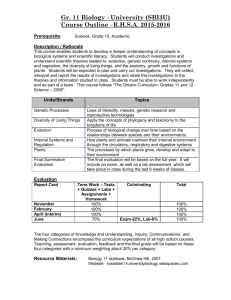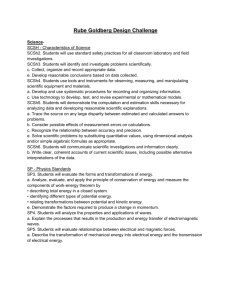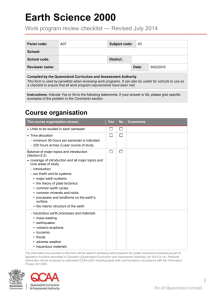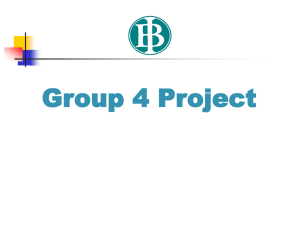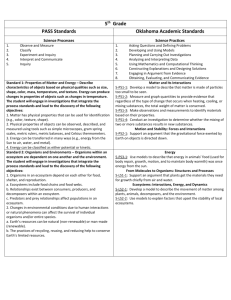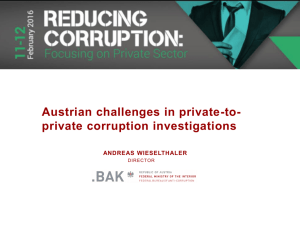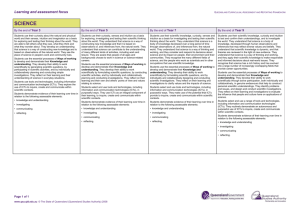Science - Queensland Curriculum and Assessment Authority
advertisement
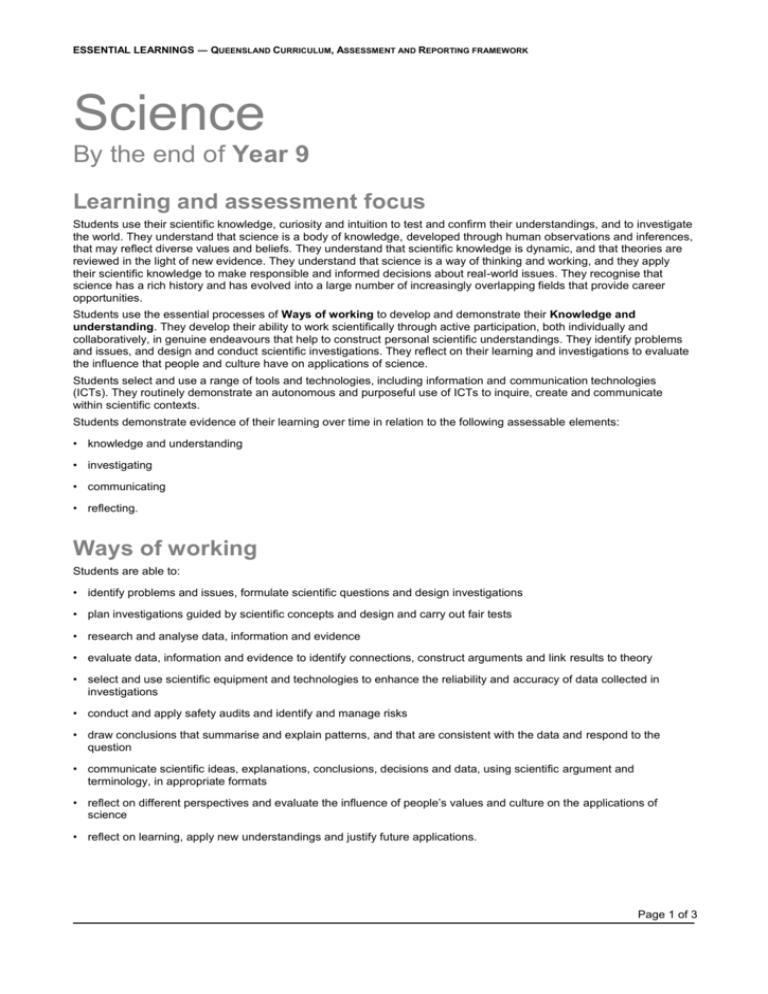
ESSENTIAL LEARNINGS ― QUEENSLAND CURRICULUM, ASSESSMENT AND REPORTING FRAMEWORK Science By the end of Year 9 Learning and assessment focus Students use their scientific knowledge, curiosity and intuition to test and confirm their understandings, and to investigate the world. They understand that science is a body of knowledge, developed through human observations and inferences, that may reflect diverse values and beliefs. They understand that scientific knowledge is dynamic, and that theories are reviewed in the light of new evidence. They understand that science is a way of thinking and working, and they apply their scientific knowledge to make responsible and informed decisions about real-world issues. They recognise that science has a rich history and has evolved into a large number of increasingly overlapping fields that provide career opportunities. Students use the essential processes of Ways of working to develop and demonstrate their Knowledge and understanding. They develop their ability to work scientifically through active participation, both individually and collaboratively, in genuine endeavours that help to construct personal scientific understandings. They identify problems and issues, and design and conduct scientific investigations. They reflect on their learning and investigations to evaluate the influence that people and culture have on applications of science. Students select and use a range of tools and technologies, including information and communication technologies (ICTs). They routinely demonstrate an autonomous and purposeful use of ICTs to inquire, create and communicate within scientific contexts. Students demonstrate evidence of their learning over time in relation to the following assessable elements: • knowledge and understanding • investigating • communicating • reflecting. Ways of working Students are able to: • identify problems and issues, formulate scientific questions and design investigations • plan investigations guided by scientific concepts and design and carry out fair tests • research and analyse data, information and evidence • evaluate data, information and evidence to identify connections, construct arguments and link results to theory • select and use scientific equipment and technologies to enhance the reliability and accuracy of data collected in investigations • conduct and apply safety audits and identify and manage risks • draw conclusions that summarise and explain patterns, and that are consistent with the data and respond to the question • communicate scientific ideas, explanations, conclusions, decisions and data, using scientific argument and terminology, in appropriate formats • reflect on different perspectives and evaluate the influence of people’s values and culture on the applications of science • reflect on learning, apply new understandings and justify future applications. Page 1 of 3 ESSENTIAL LEARNINGS ― QUEENSLAND CURRICULUM, ASSESSMENT AND REPORTING FRAMEWORK Knowledge and understanding Science as a human endeavour Responsible and informed decisions about real-world issues are influenced by the application of scientific knowledge. • Immediate and long-term consequences of human activity can be predicted by considering past and present events e.g. consequences of unsustainable use of fossil fuels can be seen in environmental impacts. • Responsible, ethical and informed decisions about social priorities often require the application of scientific understanding e.g. use of alternative forms of energy; use of recycled water; development of influenza and cervical cancer vaccines. • People from different cultures contribute to and shape the development of science e.g. Australian Indigenous knowledge can be applied to land and water management, food production and waste management. Earth and beyond Events on earth and in space are explained using scientific theories and ideas, including the geological and environmental history of the earth and the universe. • Scientific ideas and theories offer explanations about the earth that extend to the origins of the universe e.g. ideas about the expanding universe. • Global patterns of change on earth and in its atmosphere can be predicted and modelled e.g. the effects of rising temperatures on natural environments. • Geological evidence can be interpreted to provide information about past and present events e.g. the earth’s surface is shaped by volcanoes and earthquakes, which can be understood in terms of the theory of plate tectonics. Energy and change Forces and energy are identified and analysed to help understand and develop technologies, and to make predictions about events in the world. • An unbalanced force acting on a body results in a change in motion e.g. a car is slowed by friction from braking. • Objects remain stationary or in constant motion under the influence of balanced forces e.g. a book resting on a table; a vehicle travelling at constant speed. • Energy can be transferred from one medium to another e.g. the stove transfers heat to the pot of water. • Transfer of energy can vary according to the medium in which it travels e.g. some materials are good conductors of heat; light is refracted when it moves from air to water — the pencil appears to bend in a glass of water. • Energy is conserved when it is transferred or transformed e.g. a light bulb converts electrical energy into light energy and also produces heat. Page 2 of 3 ESSENTIAL LEARNINGS ― QUEENSLAND CURRICULUM, ASSESSMENT AND REPORTING FRAMEWORK Life and living Organisms interact with their environment in order to survive and reproduce. • The diversity of plants and animals can be explained using the theory of evolution through natural selection e.g. Australian marsupials would have had a common pouched ancestor. • In ecosystems, organisms interact with each other and their surroundings e.g the scavenger role of the crab in the mangroves means that it has a plentiful supply of food and it contributes by cleaning its surroundings. • Complex organisms depend on interacting body systems to meet their needs internally and with respect to their environment e.g. the digestive system processes food and the circulatory system distributes it throughout the body. • All the information required for life is a result of genetic information being passed from parent to offspring e.g. hereditary information is contained in the genes located on chromosomes. • Changes in ecosystems have causes and consequences that may be predicted e.g. bushfires destroy natural bushland, which temporarily changes the ecosystem; birds return to dried-up waterholes after rain. Natural and processed materials The properties of materials are determined by their structure and their interaction with other materials. • Changes in physical properties of substances can be explained using the particle model e.g. use of the particle model to describe states of matter. • Matter can be classified according to its structure e.g. elements and compounds, or molecules and atoms. • Chemical reactions can be described using word and balanced equations e.g. hydrogen plus oxygen gives water or 2H2 + O2 = 2H2O. • Reaction rate is affected by various factors, including temperature, concentration and surface area e.g. milk goes sour more quickly when left at room temperature; a soluble tablet will dissolve faster when it is crushed. Page 3 of 3

